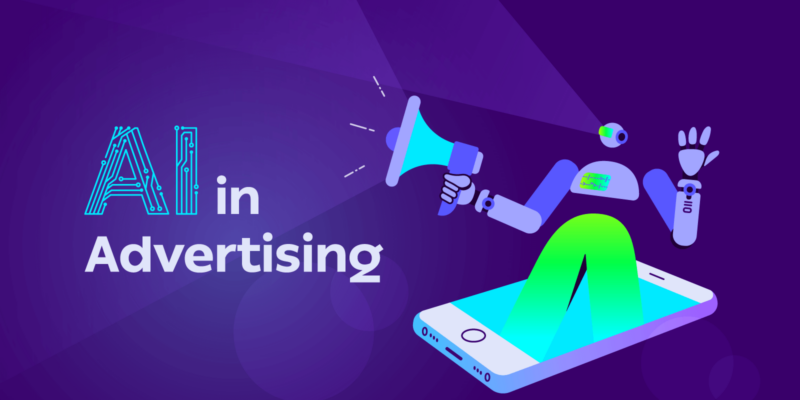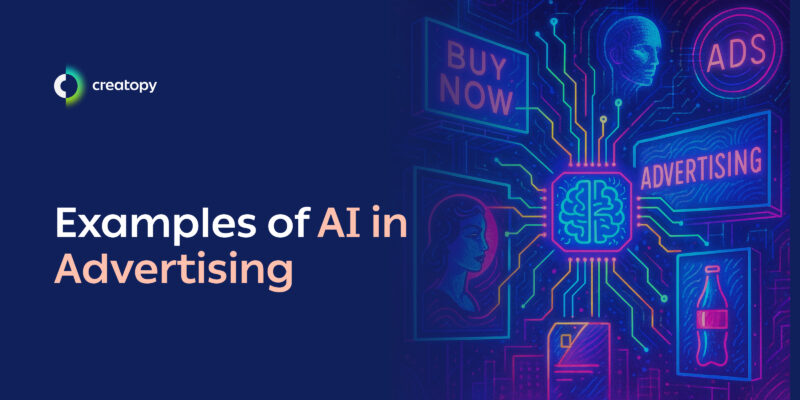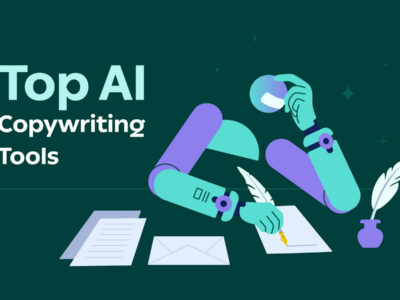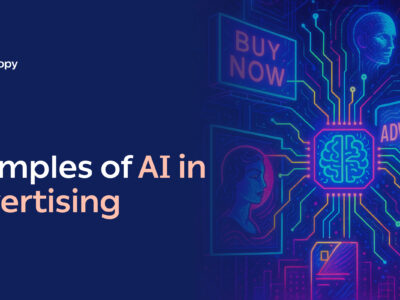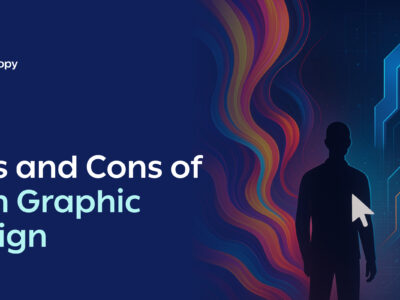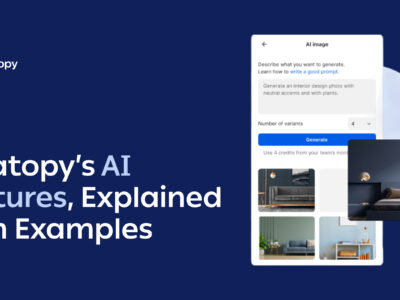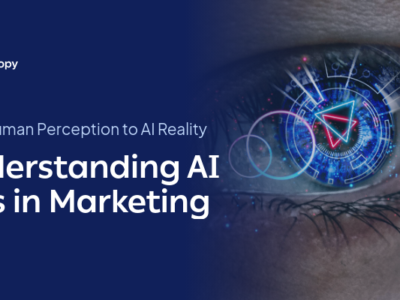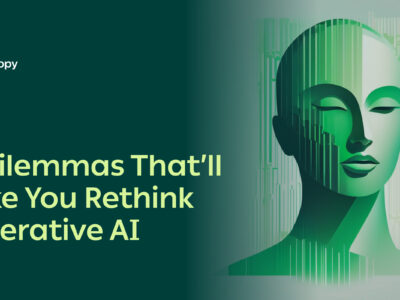AI is the buzzword of the hour. In advertising, more so than anywhere else.
You’ve probably heard it thrown around many times. Every company wants to jump on the AI bandwagon, and many already have. The latter claim AI advertising is a game-changer: it can make you more productive, help your company achieve its marketing goals more efficiently, and drive revenue.
So, should you leverage the power of artificial intelligence for your future ad campaigns?
Hopefully, this article will help you make up your mind. We’ll go over what you need to know when using AI for advertising, from benefits and downsides to tools and platforms, as well as emerging trends.
How is AI used in advertising?
How will AI impact the advertising industry?
What are the pros of AI in advertising?
What are the cons of AI in advertising?
AI advertising vs. human creativity
Examples of successful AI advertising campaigns
AI image generators in advertising
AI copy generators in advertising
AI design in advertising
AI advertising platforms and tools
The future landscape of AI advertising
But before we get to that, learn more about Creatopy’s AI vision.
How Is AI Used in Advertising?
Artificial intelligence (AI for short) refers to computers’ ability to simulate processes specific to human intelligence, such as understanding language, learning, reasoning, and problem-solving, among others.
This technology uses algorithms to analyze and interpret data and make decisions. Moreover, through machine learning, AI systems can also learn from data and improve their performance over time.
Be careful not to use AI and machine learning interchangeably, as there is a clear distinction between the two terms. Machine learning is a subset of AI that plays an important role in training and model building. Simply put, it helps AI become better and better at executing tasks in a human-like manner.
Because AI allows machines to perform tasks with little to no human intervention, it has a lot of uses, including in marketing and advertising.
Brands can now design and deliver the perfect customer experience by tapping into enormous amounts of data with minimum effort. This way, they manage to enhance various aspects of their marketing efforts, including customer interaction, content generation and personalization, sales forecasting, and so on.
But let’s see why AI and advertising go hand in hand.
Artificial intelligence technology has revolutionized the advertising landscape and continues to do so every day.
There are A LOT of use cases for AI in this field. Here are some of the key ones:
- Generating ad visuals;
- Generating ad copy;
- Audience targeting and segmentation;
- Analyzing campaign performance and finding patterns;
- Predicting campaign performance before launch;
- Personalizing ad creatives for specific audiences or users;
- Dynamic creative optimization: delivering ad variations based on user preferences;
- Real-time automated programmatic ad buying;
- Dynamic optimization of bids and budgets;
- Automated campaign reporting for easier campaign monitoring.
And the list could go on.
With this innovative technology being so powerful, there are bound to be some changes in the industry.
How Will AI Impact the Advertising Industry?
IBM’s 2022 Global AI Adoption Index revealed that 35% of businesses use AI in their processes. This number is predicted to go up this year.
The quick adoption of AI tools will cause some traditional jobs to change or even disappear completely, including in marketing and advertising.
This, together with the constant evolution of AI capabilities, is causing job insecurity among creatives. From a different perspective, it also provides opportunities for career advancement and creates new jobs like AI trainer.
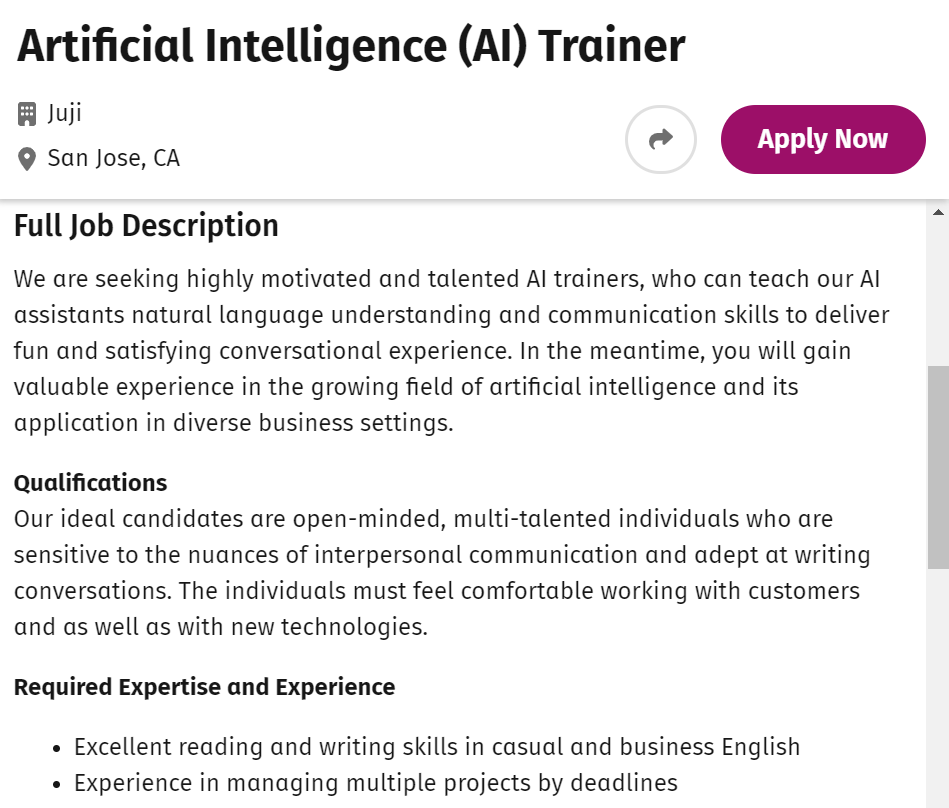
All things considered, few jobs will become obsolete. Skills like creativity, problem-solving, and critical thinking can’t be fully replicated by AI, at least not to a level that compares to humans.
Still, its ability to automate repetitive tasks and improve work efficiency cannot be ignored.
Requirements for positions in advertising are already being updated to include AI-related skills. For instance, many companies seek copywriters with expertise in using generative AI tools like chatGPT, Copy.ai, or Jasper.ai.
But copywriting is not the only advertising component where things are being done differently. There are AI-driven changes in advertising strategies and campaign management as well.
Through AI data analysis and insights, advertisers can delve into large volumes of data and find patterns that will help them craft powerful strategies.
They can also segment the audience and target ads to reach the most relevant prospects and instantly generate creatives that have the power to convert. Not to mention optimizing advertising campaigns based on real-time data to maximize performance.
This can include many things, from running A/B tests to identifying which creatives bring the best results to allocating and adjusting the budget across different campaigns and channels according to performance.
AI is indeed a tool that can help you leverage data when creating advertising strategies and managing your campaign. But, as I mentioned before, it’s important to remember that it cannot replace human expertise and strategic thinking.
Besides the obvious benefits of adopting this technology, there are also some disadvantages you should consider. We want you to have the full picture before deciding, so let’s go over the benefits and downsides of AI advertising.
What Are the Pros of AI in Advertising?
Let’s start with the positives, shall we? Here are the main advantages AI brings to the table for advertisers.
Enhanced ad targeting precision and relevance with AI algorithms
From data analysis and audience segmentation to identifying lookalike audiences who share similar traits and behaviors with current customers, there’s a lot AI can do to make ad targeting more accurate.
Moreover, it can evaluate online user searches to determine whether an individual is highly inclined to make a purchase or not. It’s also highly efficient at contextual targeting, which matches ads with relevant digital content to ensure they are relevant and valuable to the viewers.
The increase in the amount of data available, which became known as big data, plays an important role in this. By combining the power of AI algorithms with big data, advertisers can target the right person with the right ad at the right time, improving campaign performance.
These two technologies together can automate almost 80% of all physical work, 70% of data processing, and 64% of data collection tasks. Marketers can now easily manage large amounts of data to gain valuable insights about target audiences and make data-driven decisions.
Personalization at scale for improved user experience
AI can hone in on the perfect audience, but it can also help advertisers create more personalized experiences for users. There are multiple ways to do this, but the following are most relevant from the ad creative perspective:
- Tailored ad creatives: analyze user data to create personalized ad content that resonates with different audience segments.
- Predictive personalization: rely on AI-powered predictive analysis to anticipate user behavior and answer their needs by delivering ads that match their interests, increasing chances of conversion.
- Dynamic creative optimization: create and deliver dynamic ads that change their content based on user data for custom-made ad experiences.
- Customized product recommendations: serve suitable product recommendations to consumers, delivering hyper-relevant ads.
Optimized ad performance and higher ROI through AI automation
As you’ve probably gathered by now, there’s not much this technology can’t do in advertising.
Naturally, AI can also analyze campaign performance on various platforms and identify optimization opportunities the human eye could overlook.
Not only can it point out what is or isn’t working in an ad campaign, but it can also make recommendations based on current and previous campaign performance.
Using data analysis and insights will aid you in automatically optimizing targeting, bidding and budgeting, ad placements, ad creatives, and pretty much anything else.
And let’s not forget it has the ability to predict who is more likely to buy your product or service, which helps you optimize your campaigns for conversion and ultimately increase ROI.

What Are the Cons of AI in Advertising?
It’s not all smooth sailing with artificial intelligence in the realm of advertising. Let’s address some of the main concerns regarding the use of AI technology.
Privacy and data security issues with AI-powered ad targeting
Using AI in advertising has only amplified concerns surrounding data privacy. While the technology can analyze vast amounts of data, allowing for more granular segmentation and increased personalization, it also poses significant security risks.
More specifically, any personal data companies feed into AI can be disclosed to third parties or malicious actors, including sensitive customer information like health conditions, political affiliations, or financial data.
Identity theft, fraud, and account takeover are just a few examples of data privacy violations that can occur as a result. That’s why all internet users nowadays should follow common cybersecurity practices and use VPNs or proxies to protect their personal information.
As more and more brands embrace the power of AI advertising, they should also stay informed about any regulatory changes and protect their proprietary data and customer information, paying particular attention to regions with strict data protection laws, like the EU.
On the customer side, there are mixed feelings about AI ad targeting. Some display a certain level of comfort, while others are uncomfortable with the idea.

Potential algorithmic biases and their impact on ad delivery
AI can do data analysis and audience segmentation much faster than humans ever could. On the flip side of the coin, this technology is prone to algorithmic biases.
How can this be true when artificial intelligence doesn’t have ideas or opinions of its own?
Well, AI models are only as good as the data they’re built on. Bias can creep in during the development or training phase.
For instance, developers might pass their prejudiced values to the AI system they write the code for. But the most common scenario is the second one, in which biased data is used for training purposes.
Take ChatGPT as an example. It was trained using various data sources, including publicly available web pages. And we all know that besides valuable information, the internet is also crawling with disinformation and discriminatory content.
The chatbot itself can’t deny the possibility of bias.

All of this indicates AI targeted advertising can be faulty. If dealing with a gender bias, it may show certain ads predominantly to one gender over the other. A racially biased AI will unfairly prioritize a specific race while underrepresenting or excluding others. And so on.
Either way, marketers could fail to reach valuable prospects that have the potential to turn into paying customers.
Challenges in implementing AI in advertising effectively
Data privacy and potential algorithmic biases are not the only challenges advertisers face when adopting AI technology. There are a few others worth mentioning.
For starters, integrating AI usually calls for a complex implementation process, one that modifies workflows, technologies, and skill sets. This can cause hurdles along the way and even be met with resistance.
Needless to say, AI implementation can eat up quite a few resources, human and financial. It can also be time-consuming, depending on the type and magnitude of the projects. Not to mention the ongoing maintenance that’s needed afterward.
While big businesses may afford to invest in AI adoption, small businesses are not so lucky.
Given the constant advancements in artificial intelligence and the fact that, over the last few years, this technology has worked its way into every area of our lives, there is a shortage of professionals with expertise in AI advertising. You might find it difficult to get skilled individuals to develop, implement, and manage AI-driven advertising strategies.
On top of all these, there’s also the issue of data quality and availability. As stated earlier, AI technology relies heavily on data, which is becoming slightly difficult to acquire in a world where people put more value on privacy.
AI Advertising vs. Human Creativity
We’ve already established AI advertising technology can deliver excellent results in terms of effectiveness and efficiency. However, brands should leverage the strengths of both AI and human creativity if they want to stay ahead of the game.
Take ad creation, for example.
AI tools can provide valuable insight from vast amounts of data and automate repetitive tasks and workflows, but their creativity and innovation capabilities are limited.
However, AI adoption allows marketers and designers to focus on the really important stuff, which is to come up with brilliant ideas. Paired with the human capacity to empathize with others and create meaningful connections, it will lead to stronger creative assets and ad campaigns that perform better overall.
It’s a match made in heaven.
Striking the right balance between automation and artistic expression is no easy feat. It requires companies to understand the potential and limitations of each approach and combine the two to serve marketing and business goals best.
Examples of Successful AI Advertising Campaigns
Let’s look at a few examples where integrating AI advertising in campaigns was definitely the right call.
Starting with AI-targeted advertising, we have the drugstore chain CVS, which used IBM’s Watson AI platform to show contextual ads on The Weather Channel app to individuals in high-risk flu areas.
The result? Engagement rates were through the roof. They managed to show their ads to 644,000,000 users, with a 120%+ click-through rate and over 42,000,000 unique website visitors.

Continuing with AI-generated content, we had to include Lexus’ famous ad that has been entirely scripted by artificial intelligence.
Even though some voices claim the story leaves them in a fog, not completely understanding what they just watched, one thing is certain: the ad created serious buzz upon launch, being categorized as the first of its kind.
Whether that is the merit of AI or Oscar-winning director Kevin McDonald, who shot the commercial, is unclear.
Lexus might’ve been one of the first brands to experiment with generative AI in advertising, but many others have joined the trend since then.
Giant names like Nestle and Unilever reportedly use generative AI tools like ChatGPT and Dall-E to create cost-effective ad campaigns. Even Microsoft bets on AI, employing the technology to craft headlines and descriptions for ad campaigns.
Last but not least, let’s look at a real-world example of AI-powered ad personalization.
Following in the steps of CVS, Lufthansa used IBM’s AI technology to enhance one of its advertising campaigns. More specifically, they served dynamic ads on The Weather Channel properties and across Lufthansa’s media.

These ads were meant to spark conversation with users through something that resembled a personality test. Upon being completed, it revealed a travel personality and appropriate destination recommendations for each user.
The campaign had an 8% conversation rate, and it helped the brand uncover valuable insights about its target audience, paving the way for even more successful upcoming campaigns.
Explore more real-life examples of AI in advertising
AI Image Generators in Advertising
Generative AI has made a splash since its launch, especially in the visual department.
Let’s expand on the idea of using images generated with artificial intelligence and machine learning for advertising.
Understanding AI-powered image generation in ad design
Stock photos represent the most convenient option for ad design, but they can sometimes feel staged and may fail to get customers to resonate with your creatives.
Professional photoshoots are a superior choice, especially when designing product ads. However, small businesses don’t have the budgets for professional photoshoots. And businesses that do, can’t afford to invest time in the process.
With AI-powered image generation, you get the best of both worlds: it’s a cost-effective way to create visuals in a very short amount of time.
All you need to do is write a descriptive text prompt for the type of image you desire, and the AI model will generate it.
You can go for different styles like realistic, abstract, and illustrative, name colors, or describe specific feelings you want to convey. The sky is the limit for AI advertisements.
That’s the thing with images generated using artificial intelligence and machine learning. They allow you to take customization as far as you want so you can deliver tailor-made ads to your audience.
How AI image generators streamline visual content creation
Generative AI significantly cuts down the time and effort needed to create images. You can ideate quickly but also explore different styles and concepts until you find the perfect visual to grab the audience’s attention.
This allows you to scale your advertising efforts and produce high amounts of visuals for ad creatives faster.
For instance, if you have a wide range of products you want to promote individually, AI can generate countless images showcasing each in various settings in a matter of seconds.
Additionally, you can use generative AI when making ad variants for A/B tests where the image is the variable.
An additional benefit is that the technology is accessible to anyone, meaning not only experienced designers can use artificial intelligence to create visuals, but marketers can do it too. This can increase the efficiency of your creative team and reduce budgets.
Examples of AI-generated images used in successful ad campaigns
Since examples carry more weight than words, let’s look over a few AI-generated images used for advertising purposes.
Heinz

I couldn’t help but bring up the famous food products brand that saw an opportunity and made the most of it.
They noticed that whenever asked to generate images of ketchup, more often than not, DALL-E 2 would come up with bottles that resemble their iconic packaging.
The result was their ad campaign with visuals generated entirely by AI and the tagline “This is what ketchup looks like to AI. It has to be Heinz.”
Coca-Cola

On to another gigantic brand that jumped on the generative AI bandwagon, we have Coca-Cola.
The famous company prompted (pun intended) users to generate branded art on a platform that combines OpenAI’s GPT-4 and DALL-E technologies.
Although the AI-generated images are not ads per se, they can be submitted for a chance to be displayed on digital billboards in New York’s Time Square and London’s Piccadilly Circus.
Delta Air Lines

You got me. This is not actually an official Delta Air Lines ad campaign.
It is a remake of one that someone created using generative AI. However, I wanted to include it here because it demonstrates the benefits of this technology, especially how effective it is in generating ad designs that look authentic.
AI Copy Generators in Advertising
Images are not the only ad design resources you can generate using AI. There’s also text.
In fact, this latter form of genAI is probably the most widely adopted overall, being used in fields like journalism, education, or tourism.
Here’s how AI copy generators are making an impact in advertising.
Exploring the use of AI in generating ad copy and content
Artificial intelligence technology can be used to produce ad copy, website and blog content, social media posts, or any other kind of written promotional material.
AI technology generates content in a fraction of the time a human copywriter would. It can emulate different writing styles, instantly switch the tone of voice, provide entertainment value, and even elicit emotions.
In addition to this, an AI copy generator can adjust copy length, rephrase the text, and fix spelling mistakes to ensure the message that reaches your audience is perfectly written.
Benefits of AI copy generators for ad campaigns
The selling point of generative AI technology is efficiency, and AI copy tools make no exception. They automate writing, which is usually a time-consuming process, and help you launch ad campaigns faster than you normally would.
Another benefit of this technology is that it allows you to combine data analysis with copywriting to develop tailor-made ad messages for specific audiences and/or individuals.
For example, in the case of the retail industry, advertisers can use information like purchase history or product preferences to get personalized ad copy and increase the chances of conversion.
AI text tools can also rapidly generate written content for localized ad campaigns. They can automatically translate ad copy into different languages, maintaining the original intent and style while adapting to foreign markets.
Effectiveness and limitations of AI-generated copy
All benefits considered AI-generated copy is not quite there yet when it comes to quality. Human editing is sometimes required for content to be ready for publishing.
On top of this, AI-generated ad copy may sometimes fail to connect with the audience as well as text written by a human. Of course, this isn’t always the case—there are instances in which it performs really well.
Despite these potential disadvantages, using genAI for copywriting greatly simplifies the process. If you’ve ever used such a tool, I’m sure you agree.
AI Design in Advertising
Harnessing AI for design tasks in ad creation can streamline the production process and enhance efficiency.
That’s why many ad design and creative automation tools have integrated AI-powered functionalities. They usually incorporate image and copy generators, AI animations, and background removal, among other things.
These assist designers and marketers from the ideation phase of a campaign all the way through to ad delivery.
Naturally, AI plays a huge role in generating visual elements. However, it can also assist designers in creating layouts that display assets like images and text in a visually appealing composition.
But perhaps the smartest way of using AI for advertising design is to generate multiple ad variations starting from an idea in just a few moments. This removes much of the repetitive work and helps you explore different concepts and choose the best one.
AI Advertising Platforms and Tools
AI tools spring up like mushrooms nowadays. But out of the overwhelming number of options, a few software stand out. These can truly elevate your ad production process and increase your productivity levels while lowering budgets or, at least, keeping them the same.
As you might know, there are AI advertising tools for various needs, so the list below is divided into the most popular and relevant categories:
Image generation AI tools

- DALL-E 2 → the most popular option in this category—it creates realistic images and art from a description;
- Midjourney → gaining in popularity, this tool creates images based on text prompts, just like DALL-E 2;
- Starry AI → with a focus on art, Starry AI generates images in mere seconds;
- Jasper Art → quick text-to-image generation with style, medium, and artist options for better results;
- Dream by WOMBO → rapidly produces artwork in over 15 different art styles.
Video generation AI tools

- Pictory → generates video creatives based on scripts or other written content;
- Synthesys → creates videos, images, voiceovers, and more types of content;
- Synthesia → produces videos in over 120 languages, accents, and voice tones;
- HeyGen → text to video with 300+ voices available in 40+ languages or uploaded voice recordings;
- Deepbrain AI → text to video from a script, plus prebuilt video templates for various video types.
Copy generation AI tools

- ChatGPT → generates, summarizes, and translates content;
- Jsper AI → creates original content or rephrases into different formats, tones, and languages;
- Copy.ai → crafts personalized copy for blogs, social media, emails, and many others;
- Copysmith → generates high-quality product content at scale;
- QuillBot → only works for rephrasing content in creative ways.
The Future Landscape of AI Advertising
As AI technologies evolve, so will their role in marketing and advertising. Let’s take a closer look at why AI is the future of advertising.
Traditional advertising usually follows a reactive pattern, meaning users must display signs of interest and engagement before they are shown ads. AI-powered advertising shifts things towards proactive ad delivery.
Its predictive analytics capabilities allow it to anticipate behavior so it can serve relevant ads even to users who haven’t actively searched for products.
For instance, if past behavior indicates someone could be interested in yoga, they will see ads for mats or blocks when landing on a random website like the New York Times.
There’s also an inclination towards the hyper-personalization of ads using this technology. AI-driven dynamic creative optimization for real-time personalization is gaining traction—more and more brands are adapting various elements of the creative, such as images, text, colors, and layouts, based on user preferences, behavior, demographics, and other relevant data.
Rob May, founder and CEO of Nova AI, also predicts that brands will create their own AI models, trained on their own data. This could reduce concerns regarding privacy or algorithmic bias.
All these emerging trends point towards AI’s dominant role in the future of advertising, but despite the high number of possibilities, no one can say for certain how things will go.
The best thing marketers and advertisers can do is closely follow the AI news within the industry and see how they can leverage new developments for their business growth.
Wrapping Up
Artificial intelligence is a powerful instrument that can enhance targeting, personalization, optimization, and the overall efficiency of ad campaigns.
If you haven’t implemented AI tools in your advertising strategy until now, this is a good time to do it. Swimming against the current is an alternative, but it will likely cause you to lose ground to competitors that leverage this technology.
What advertising use case for AI seems more appealing to you? Is it personalized content generation, audience segmentation, and targeting, campaign optimization, or something else? Let us know in the comments below.

